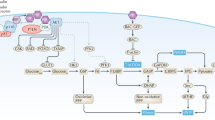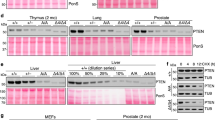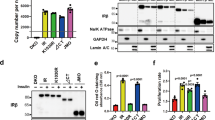Abstract
Many tumors have chronically elevated activity of PI 3-kinase-dependent signaling pathways, caused largely by oncogenic mutation of PI 3-kinase itself or loss of the opposing tumor suppressor lipid phosphatase, PTEN. Several PI 3-kinase-dependent feedback mechanisms have been identified that may affect the sensitivity of upstream receptor signaling, but the events required to initiate an inhibited state have not been addressed. We show that in a variety of cell types, loss of PTEN via experimental knockdown or in tumor cell lines correlates with a block in insulin-like growth factor 1 (IGF1)/insulin signaling, without affecting the sensitivity of platelet-derived growth factor or epidermal growth factor signaling. These effects on IGF/insulin signaling include a reduction of up to five- to tenfold in IGF-stimulated PI 3-kinase activation, a failure to activate the ERK kinases and, in some cells, reduced expression of insulin receptor substrate 1, and both IGF1 and insulin receptors. These data indicate that chronically elevated PI 3-kinase-dependent signaling to the degree seen in many tumors causes a selective loss of sensitivity in IGF1/insulin signaling that could significantly reduce the selective advantage of deregulated activation of IGF1/IGF1-R signaling in tumor development.
This is a preview of subscription content, access via your institution
Access options
Subscribe to this journal
Receive 50 print issues and online access
$259.00 per year
only $5.18 per issue
Buy this article
- Purchase on Springer Link
- Instant access to full article PDF
Prices may be subject to local taxes which are calculated during checkout






Similar content being viewed by others
References
Batty IH, Fleming IN, Downes CP . (2004). Muscarinic-receptor-mediated inhibition of insulin-like growth factor-1 receptor-stimulated phosphoinositide 3-kinase signalling in 1321N1 astrocytoma cells. Biochem J 379: 641–651.
Board R, Jayson GC . (2005). Platelet-derived growth factor receptor (PDGFR): a target for anticancer therapeutics. Drug Resist Updat 8: 75–83.
Cheung PC, Campbell DG, Nebreda AR, Cohen P . (2003). Feedback control of the protein kinase TAK1 by SAPK2a/p38alpha. EMBO J 22: 5793–5805.
Cully M, You H, Levine AJ, Mak TW . (2006). Beyond PTEN mutations: the PI3K pathway as an integrator of multiple inputs during tumorigenesis. Nat Rev Cancer 6: 184–192.
Cutillas PR, Khwaja A, Graupera M, Pearce W, Gharbi S, Waterfield M et al. (2006). Ultrasensitive and absolute quantification of the phosphoinositide 3-kinase/Akt signal transduction pathway by mass spectrometry. Proc Natl Acad Sci USA 103: 8959–8964.
Danilkovitch-Miagkova A, Zbar B . (2002). Dysregulation of Met receptor tyrosine kinase activity in invasive tumors. J Clin Invest 109: 863–867.
Darragh J, Soloaga A, Beardmore VA, Wingate AD, Wiggin GR, Peggie M et al. (2005). MSKs are required for the transcription of the nuclear orphan receptors Nur77, Nurr1 and Nor1 downstream of MAPK signalling. Biochem J 390: 749–759.
Fisher TL, White MF . (2004). Signaling pathways: the benefits of good communication. Curr Biol 14: R1005–R1007.
Foukas LC, Claret M, Pearce W, Okkenhaug K, Meek S, Peskett E et al. (2006). Critical role for the p110alpha phosphoinositide-3-OH kinase in growth and metabolic regulation. Nature 441: 366–370.
Harrington LS, Findlay GM, Lamb RF . (2005). Restraining PI3K: mTOR signalling goes back to the membrane. Trends Biochem Sci 30: 35–42.
Harrington LS, Findlay GM, Gray A, Tolkacheva T, Wigfield S, Rebholz H et al. (2004). The TSC1-2 tumor suppressor controls insulin-PI3K signaling via regulation of IRS proteins. J Cell Biol 166: 213–223.
Hellawell GO, Turner GD, Davies DR, Poulsom R, Brewster SF, Macaulay VM . (2002). Expression of the type 1 insulin-like growth factor receptor is up-regulated in primary prostate cancer and commonly persists in metastatic disease. Cancer Res 62: 2942–2950.
Jackson JG, Yee D . (1999). IRS-1 expression and activation are not sufficient to activate downstream pathways and enable IGF-I growth response in estrogen receptor negative breast cancer cells. Growth Horm IGF Res 9: 280–289.
Javelaud D, Mauviel A . (2005). Crosstalk mechanisms between the mitogen-activated protein kinase pathways and Smad signaling downstream of TGF-beta: implications for carcinogenesis. Oncogene 24: 5742–5750.
Keeton AB, Bortoff KD, Franklin JL, Messina JL . (2005). Blockade of rapid versus prolonged extracellularly regulated kinase 1/2 activation has differential effects on insulin-induced gene expression. Endocrinology 146: 2716–2725.
Kiepe D, Ciarmatori S, Hoeflich A, Wolf E, Tonshoff B . (2005). Insulin-like growth factor (IGF)-I stimulates cell proliferation and induces IGF binding protein (IGFBP)-3 and IGFBP-5 gene expression in cultured growth plate chondrocytes via distinct signaling pathways. Endocrinology 146: 3096–3104.
Knight ZA, Gonzalez B, Feldman ME, Zunder ER, Goldenberg DD, Williams O et al. (2006). A pharmacological map of the PI3-K family defines a role for p110alpha in insulin signaling. Cell 125: 733–747.
Lam K, Carpenter CL, Ruderman NB, Friel JC, Kelly KL . (1994). The phosphatidylinositol 3-kinase serine kinase phosphorylates IRS-1. Stimulation by insulin and inhibition by Wortmannin. J Biol Chem 269: 20648–20652.
LeRoith D, Roberts Jr CT . (2003). The insulin-like growth factor system and cancer. Cancer Lett 195: 127–137.
Leslie NR, Bennett D, Gray A, Pass I, Hoang-Xuan K, Downes CP . (2001). Targeting mutants of PTEN reveal distinct subsets of tumour suppressor functions. Biochem J 357: 427–435.
Liu YF, Paz K, Herschkovitz A, Alt A, Tennenbaum T, Sampson SR et al. (2001). Insulin stimulates PKCzeta-mediated phosphorylation of insulin receptor substrate-1 (IRS-1). A self-attenuated mechanism to negatively regulate the function of IRS proteins. J Biol Chem 276: 14459–14465.
Macrae M, Neve RM, Rodriguez-Viciana P, Haqq C, Yeh J, Chen C et al. (2005). A conditional feedback loop regulates Ras activity through EphA2. Cancer Cell 8: 111–118.
Mise-Omata S, Obata Y, Iwase S, Mise N, Doi TS . (2005). Transient strong reduction of PTEN expression by specific RNAi induces loss of adhesion of the cells. Biochem Biophys Res Commun 328: 1034–1042.
Mitsiades CS, Mitsiades NS, McMullan CJ, Poulaki V, Shringarpure R, Akiyama M et al. (2004). Inhibition of the insulin-like growth factor receptor-1 tyrosine kinase activity as a therapeutic strategy for multiple myeloma, other hematologic malignancies, and solid tumors. Cancer Cell 5: 221–230.
Myers MP, Pass I, Batty IH, Van der Kaay J, Stolarov JP, Hemmings BA et al. (1998). The lipid phosphatase activity of PTEN is critical for its tumor supressor function. Proc Natl Acad Sci USA 95: 13513–13518.
Natarajan M, Lin KM, Hsueh RC, Sternweis PC, Ranganathan R . (2006). A global analysis of cross-talk in a mammalian cellular signalling network. Nat Cell Biol 8: 571–580.
O'Reilly KE, Rojo F, She QB, Solit D, Mills GB, Smith D et al. (2006). mTOR inhibition induces upstream receptor tyrosine kinase signaling and activates Akt. Cancer Res 66: 1500–1508.
Parrizas M, Saltiel AR, LeRoith D . (1997). Insulin-like growth factor 1 inhibits apoptosis using the phosphatidylinositol 3′-kinase and mitogen-activated protein kinase pathways. J Biol Chem 272: 154–161.
Pirola L, Johnston AM, Van Obberghen E . (2004). Modulation of insulin action. Diabetologia 47: 170–184.
Ravichandran LV, Esposito DL, Chen J, Quon MJ . (2001). Protein kinase C-zeta phosphorylates insulin receptor substrate-1 and impairs its ability to activate phosphatidylinositol 3-kinase in response to insulin. J Biol Chem 276: 3543–3549.
Sajan MP, Standaert ML, Bandyopadhyay G, Quon MJ, Burke Jr TR, Farese RV . (1999). Protein kinase C-zeta and phosphoinositide-dependent protein kinase-1 are required for insulin-induced activation of ERK in rat adipocytes. J Biol Chem 274: 30495–30500.
Shaw RJ, Cantley LC . (2006). Ras, PI(3)K and mTOR signalling controls tumour cell growth. Nature 441: 424–430.
Shelton JG, Steelman LS, Abrams SL, Bertrand FE, Franklin RA, McMahon M et al. (2005). The epidermal growth factor receptor gene family as a target for therapeutic intervention in numerous cancers: what's genetics got to do with it? Expert Opin Ther Targets 9: 1009–1030.
Simpson L, Li J, Liaw D, Hennessy I, Oliner J, Christians F et al. (2001). PTEN expression causes feedback upregulation of insulin receptor substrate 2. Mol Cell Biol 21: 3947–3958.
Stiles B, Gilman V, Khanzenzon N, Lesche R, Li A, Qiao R et al. (2002). Essential role of AKT-1/protein kinase B alpha in PTEN-controlled tumorigenesis. Mol Cell Biol 22: 3842–3851.
Stocker H, Andjelkovic M, Oldham S, Laffargue M, Wymann MP, Hemmings BA et al. (2002). Living with lethal PIP3 levels: viability of flies lacking PTEN restored by a PH domain mutation in Akt/PKB. Science 295: 2088–2091.
Um SH, D'Alessio D, Thomas G . (2006). Nutrient overload, insulin resistance, and ribosomal protein S6 kinase 1, S6K1. Cell Metab 3: 393–402.
Um SH, Frigerio F, Watanabe M, Picard F, Joaquin M, Sticker M et al. (2004). Absence of S6K1 protects against age- and diet-induced obesity while enhancing insulin sensitivity. Nature 431: 200–205.
Vivekanand P, Rebay I . (2006). Intersection of signal transduction pathways and development. Annu Rev Genet 40: 139–157.
White MF . (2002). IRS proteins and the common path to diabetes. Am J Physiol Endocrinol Metab 283: E413–E422.
Acknowledgements
We thank Rodolfo Marquez for the PI3-kinase inhibitor PI-103 and Doreen Cantrell, Bart Vanhaesebroeck and Dario Alessi for expression constructs. This work was supported by the Medical Research Council, the Association for International Cancer Research and the Dundee DSTT consortium (Astra Zeneca, Boehringer Ingelheim, GlaxoSmithKline, Merck and Co., Merck KGaA and Pfizer).
Author information
Authors and Affiliations
Corresponding author
Additional information
Supplementary Information accompanies the paper on the Oncogene website (http://www.nature.com/onc).
Supplementary information
Rights and permissions
About this article
Cite this article
Lackey, J., Barnett, J., Davidson, L. et al. Loss of PTEN selectively desensitizes upstream IGF1 and insulin signaling. Oncogene 26, 7132–7142 (2007). https://doi.org/10.1038/sj.onc.1210520
Received:
Revised:
Accepted:
Published:
Issue Date:
DOI: https://doi.org/10.1038/sj.onc.1210520
Keywords
This article is cited by
-
PTEN is a protein tyrosine phosphatase for IRS1
Nature Structural & Molecular Biology (2014)
-
Swimming exercise training-induced left ventricular hypertrophy involves microRNAs and synergistic regulation of the PI3K/AKT/mTOR signaling pathway
European Journal of Applied Physiology (2013)
-
Igf2 ligand dependency of Pten+/− developmental and tumour phenotypes in the mouse
Oncogene (2012)
-
Suppression of cellular proliferation and invasion by the concerted lipid and protein phosphatase activities of PTEN
Oncogene (2010)



